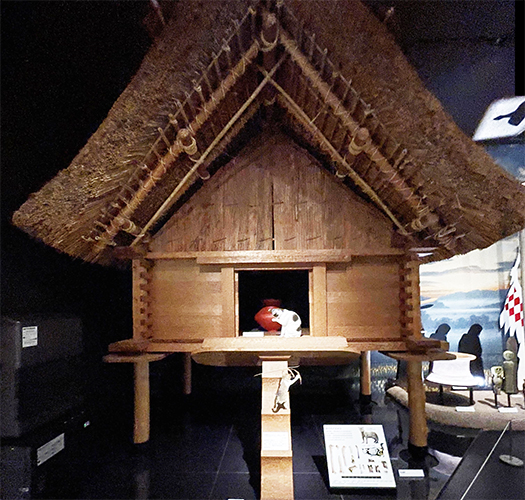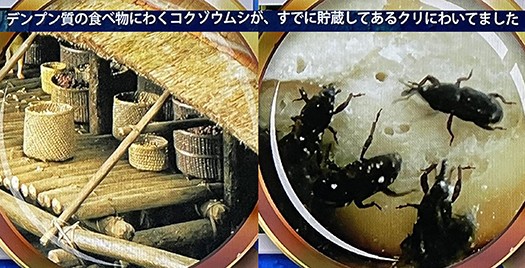


食糧生産の革命だった農業革命は「備蓄」を可能にした。
その保存のために「高床式」という通風重視の建築が最初期から営まれた。
床下空間を広く開放して食糧を土面からの湿度から保全した。
こういう高床の建築思想は南方島嶼での人類知の結果なのだろう。
高床については縄文期の三内丸山遺跡でも「クリ」の貯蔵などで
推定例が確認され、そこでは「コクゾウムシ」痕跡も見られるという。
微生物の世界でも歴史は刻印されている。
コメ生産では、最初期からこの高床での貯蔵がワンセットの概念とされる。
で、高床倉庫ではよく「ネズミ返し」の工夫などが見られるけれど、
収穫された食糧の大敵はネズミによる食害。
その食害への安全保障策としての対策が講じられることになった。
最上策として、列島の自然環境の中ではそれまでいなかった
ネコを「輸入して」積極的に飼育しイエネコとして採用し
対ネズミとして軍事的に戦おう、という人類戦略が確認できる。
いわば稲作の推進の当然の帰結として導入される結果になった。
というか、日本列島に稲作が上陸した段階というのは
稲作文明が相当進化した段階であって、さまざまな農作の経験知が
「一気に」導入された実態が浮かび上がってくる。
従来の日本史では仏教伝来とともに紙の経典のネズミ食害を防ぐために
大陸から持ってこられた、というネコ列島起源説が語られていたけれど、
稲作文化と同時に渡来していた、という説が有力になってきた。
娘とは違ってわたし自身はネコにはほとんど興味が無いけれど、
そう考えると、ネコという愛玩動物もまた歴史的に新しい存在となる。
人類社会、その進化というのは非常に奥行きの深い世界。
イヌやネコといった人類の有用動物として接近してきた動物種との歴史って
もっと太古の昔からのことと漠然と思っていたけれど、
そもそも現生人類の歴史自体、7-8万年なのだから
必ず始原期というものがあってその痕跡をたどれるのは道理。
ネコが列島に棲息しはじめたのは農耕革命、弥生の世からなのだ。
どんなに遡っても高々3000年程度、
ブログシリーズタイトルの37,000年史からすればごく最近。
紆余曲折があってか、平安期には貴族の高級ペットだったともいう。
ともあれ、始原期にはこういう高床倉庫での対ネズミ戦争の「傭兵」として
武力機能を期待されて導入されていたというのですね。
東アジア大陸社会でも、ネコは中東方面からの輸入動物種だったとされ、
案外と人類との縁はごく最近深まってきたのだ。
イヌの方はもっと古く1万年前頃の最終氷期以降とされる。
考古からのフィードバックによってこういうペットたちとの歴史まで
思わぬ新発見をわたしたちにもたらしてくれる。
ひょっとすると犬好き、猫好きという人間の嗜好性についても
科学的、DNA的に解明されていく可能性もありそうですね。
English version⬇
The Perpetual War between Cats and Rats from Yayoi: 37,000 Years of the Japanese Archipelago – 30
Historical traces in the relationship with cats. Warriors continue to fight against the rat army as mercenaries in a warehouse of agricultural products on stilts. …
The agricultural revolution, which was a revolution in food production, made “stockpiling” possible.
In order to preserve the food, “stilts,” a type of architecture that emphasized ventilation, was practiced from the beginning.
The space under the floor was opened widely to protect the food from the humidity from the soil.
This architectural concept of stilts is probably the result of human knowledge of the southern islands.
There are presumed examples of stilts at the Sannai-Maruyama site during the Jomon period, such as those used to store chestnuts.
There, traces of the weevil are said to have been found.
History is also imprinted in the world of microorganisms.
In rice production, storage on stilts has been a set concept since the beginning.
In the high-floor warehouses, one can often see the ingenious “rat repellent” method.
The great enemy of preservation of harvested food is the rodent infestation.
Therefore, measures were taken as a security measure against such food damage.
As the best measure, they “imported” cats, which had not existed in the natural environment of the archipelago until then, and actively introduced them to Japan.
Cats, which had never existed in the natural environment of the archipelago, were “imported,” actively bred, and adopted as Aエネko (Aedes aegypti).
The concept of fighting militarily against rats can also be confirmed.
The introduction of the cat, so to speak, was a natural consequence of the promotion of rice cultivation.
The stage when rice cultivation landed on the Japanese archipelago was the stage when rice civilization had evolved considerably.
the stage of considerable evolution of rice cultivation civilization, and the actual situation in which various kinds of
The reality of the “sudden” introduction of various agricultural experiences and knowledge comes to the fore.
In conventional Japanese history, the introduction of Buddhism was accompanied by the introduction of cats, which were brought from the continent to prevent rodents from eating the sutras, but this was not the case with the arrival of rice cultivation.
However, the origin of cats in the archipelago was said to be that they were brought from the continent with the arrival of Buddhism
However, the theory that they came to Japan at the same time as the rice culture is gaining strength.
Although I myself had little interest in cats
But, in that sense, the cat as a pet animal is also a new existence in history.
Human society and its evolution is a very deep world.
The history of dogs, cats, and other animal species that have come close to being useful to humans
I had vaguely thought that the history with animal species that approached humans as useful animals, such as dogs and cats, goes back much further than the earliest times.
But the history of present-day humans itself is only 70,000 to 80,000 years old.
It is only logical that there must have been a primordial period, which can be traced as traces.
Cats began to inhabit the archipelago during the agricultural revolution of the Yayoi period.
That would mean that no matter how far back in time we go, it would only be about 3,000 years at the most.
In the context of the 37,000-year history of the title of this blog series, this is very recent.
It is said that the pet was a luxury pet of the aristocracy during the Heian period (794-1192).
Anyway, in the primitive period, they were introduced as “mercenaries” in the war against rats in stilt warehouses like this.
In East Asia, cats were also introduced as “mercenaries” in the war against rats in stilt warehouses.
It is said that cats were imported from the Middle East even in East Asian continental societies.
The relationship between cats and humans has deepened more recently than one might expect.
Canines are thought to be much older, dating back to the Paleolithic and Last Glacial Period, 10,000 years ago.
Feedback from archaeology has led to unexpected new discoveries about the history of our pets.
The history with these pets also brings us unexpected new discoveries through feedback from archaeology.
Perhaps the human preference for dogs and cats will be scientifically and DNA
It is possible that the human preference for dogs and cats will also be scientifically and DNA-based elucidated.
Posted on 11月 30th, 2022 by 三木 奎吾
Filed under: 日本社会・文化研究, 歴史探訪







コメントを投稿
「※誹謗中傷や、悪意のある書き込み、営利目的などのコメントを防ぐために、投稿された全てのコメントは一時的に保留されますのでご了承ください。」
You must be logged in to post a comment.